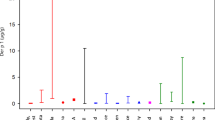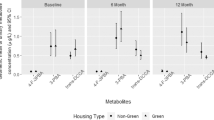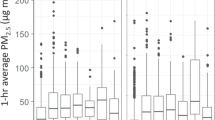Abstract
Application of pyrethroid insecticides in residential settings may result in children’s exposures to these chemicals and possible adverse health effects. Household dust is a recognized reservoir for pyrethroids and a potential medium for multi-route pyrethroid exposure. Young children move and play in a manner that resuspends dust, and since their breathing zone is close to the floor, they will have higher inhalation exposure to pesticide-laden dust than other age groups. Directly measuring a toddler’s exposure to household dust presents many logistic challenges. We simulated the dust resuspension induced by a toddler using a robot, which also served as a platform to collect air samples at the toddler’s breathing zone height. We performed simulated pyrethroid residential spray and dust resuspension experiments on vinyl and carpeted floors. The mean pyrethroid airborne concentrations in the stationary and mobile samples were 0.065 μg/m3 and 0.143 μg/m3 for the vinyl floor with 1 g/m2 dust loading, and 0.034 μg/m3 and 0.061 μg/m3 for the carpeted floor with 10 g/m2 dust loading, respectively. Pyrethroids concentrations in the settled dust samples were significantly lower than that measured in the stationary and mobile samples in the carpeted floor experiments. Thus, the use of stationary samples and settled dust samples may underestimate a toddler’s personal inhalation exposure to pyrethroids in residential houses.
This is a preview of subscription content, access via your institution
Access options
Subscribe to this journal
Receive 6 print issues and online access
$259.00 per year
only $43.17 per issue
Buy this article
- Purchase on Springer Link
- Instant access to full article PDF
Prices may be subject to local taxes which are calculated during checkout



Similar content being viewed by others
References
Grube A, Donaldson D, Kiely T, Wu L. Pesticides industry sales and usage. US EPA, Washington, DC. 2011.
Hudson NL, Kasner EJ, Beckman J, Mehler L, Schwartz A, Higgins S, et al. Characteristics and magnitude of acute pesticide‐related illnesses and injuries associated with pyrethrin and pyrethroid exposures-11 states, 2000–2008. Am J Ind Med. 2014;57:15–30.
Jurewicz J, Hanke W, Johansson C, Lundqvist C, Ceccatelli S, Van Den Hazel P, et al. Adverse health effects of children’s exposure to pesticides: what do we really know and what can be done about it. Acta Paediatr. 2006;95(s453):71–80.
Morgan MK. Children’s exposures to pyrethroid insecticides at home: a review of data collected in published exposure measurement studies conducted in the United States. Int J Environ Res Public Health. 2012;9:2964–85.
Lu C, Barr DB, Pearson M, Bartell S, Bravo R. A longitudinal approach to assessing urban and suburban children’s exposure to pyrethroid pesticides. Environ Health Perspect. 2006;114:1419.
Morgan MK, Sheldon LS, Croghan CW, Jones PA, Chuang JC, Wilson NK. An observational study of 127 preschool children at their homes and daycare centers in Ohio: environmental pathways to cis-and trans-permethrin exposure. Environ Res. 2007;104:266–74.
Bradman A, Whitaker D, Quirós L, Castorina R, Henn BC, Nishioka M, et al. Pesticides and their metabolites in the homes and urine of farmworker children living in the Salinas Valley, CA. J Expo Sci Environ Epidemiol. 2007;17:331–49.
Lu C, Schenck FJ, Pearson MA, Wong JW. Assessing children’s dietary pesticide exposure: direct measurement of pesticide residues in 24-hr duplicate food samples. Environ Health Perspect. 2010;118:1625.
Julien R, Adamkiewicz G, Levy JI, Bennett D, Nishioka M, Spengler JD. Pesticide loadings of select organophosphate and pyrethroid pesticides in urban public housing. J Expo Sci Environ Epidemiol. 2008;18:167.
Tulve NS, Egeghy PP, Fortmann RC, Whitaker DA, Nishioka MG, Naeher LP, et al. Multimedia measurements and activity patterns in an observational pilot study of nine young children. J Expo Sci Environ Epidemiol. 2008;18:31.
Naeher LP, Tulve NS, Egeghy PP, Barr DB, Adetona O, Fortmann RC, et al. Organophosphorus and pyrethroid insecticide urinary metabolite concentrations in young children living in a southeastern United States city. Sci Total Environ. 2010;408:1145–53.
Quirós-Alcalá L, Bradman A, Nishioka M, Harnly ME, Hubbard A, McKone TE, et al. Pesticides in house dust from urban and farmworker households in California: an observational measurement study. Environ Health. 2011;10:19.
Weschler CJ, Nazaroff WW. SVOC partitioning between the gas phase and settled dust indoors. Atmos Environ. 2010;44:3609–20.
World Health Organization. Summary of principles for evaluating health risks in children associated with exposure to chemicals. 2011.
Galea KS, MacCalman L, Jones K, Cocker J, Teedon P, Sleeuwenhoek AJ, et al. Biological monitoring of pesticide exposures in residents living near agricultural land. BMC Public Health. 2011;11:856.
Klepeis NE, Nelson WC, Ott WR, Robinson JP, Tsang AM, Switzer P, et al. The National Human Activity Pattern Survey (NHAPS): a resource for assessing exposure to environmental pollutants. J Expo Sci Environ Epidemiol. 2001;11:231.
Buan KD Particulate matter concentrations at children and adult breathing heights in residential thirdhand smoke environments (doctoral dissertation). San Diego State University, 2014 132148819X.
Hubal EC, Sheldon LS, Burke JM, McCurdy TR, Berry MR, Rigas ML, et al. Children’s exposure assessment: a review of factors influencing children’s exposure, and the data available to characterize and assess that exposure. Environ Health Perspect. 2000;108:475.
Freeman NC, Hore P, Black K, Jimenez M, Sheldon L, Tulve N, et al. Contributions of children’s activities to pesticide hand loadings following residential pesticide application. J Expo Sci Environ Epidemiol. 2005;15:81.
Tulve NS, Egeghy PP, Fortmann RC, Xue J, Evans J, Whitaker DA, et al. Methodologies for estimating cumulative human exposures to current-use pyrethroid pesticides. J Expo Sci Environ Epidemiol. 2011;21:317.
Todd G, Wohlers D, Citra M. Toxicological profile for pyrethrins and pyrethroids, ATSDR, US. Department of Health and Human Services. Public Health Service, Atlanta, Georgia, USA. 2003.
Thatcher TL, Layton DW. Deposition, resuspension, and penetration of particles within a residence. Atmos Environ. 1995;29:1487–97.
Roberts JW, Dickey P. Exposure of children to pollutants in house dust and indoor air. Reviews of Environmental Contamination and Toxicology: Springer; 1995. p. 59-78.
Lioy PJ, Freeman NC, Millette JR. Dust: a metric for use in residential and building exposure assessment and source characterization. Environ Health Perspect. 2002;110:969.
McCormack MC, Breysse PN, Matsui EC, Hansel NN, Williams DA, Curtin-Brosnan J, et al. In-home particle concentrations and childhood asthma morbidity. Environ Health Perspect. 2009;117:294.
U.S. Environmental Protection Agency. A standardized EPA protocol for characterizing indoor air quality in large office buildings. Indoor Environment Division, U.S. EPA, Washington, DC. 2003.
Sagona JA, Shalat SL, Wang Z, Ramagopal M, Black K, Hernandez M, et al. Evaluation of particle resuspension in young children׳ s breathing zone using stationary and robotic (PIPER) aerosol samplers. J Aerosol Sci. 2015;85:30–41.
Dodson RE, Camann DE, Morello-Frosch R, Brody JG, Rudel RA. Semivolatile organic compounds in homes: strategies for efficient and systematic exposure measurement based on empirical and theoretical factors. Environ Sci Technol. 2014;49:113–22.
Whitehead T, Metayer C, Buffler P, Rappaport SM. Estimating exposures to indoor contaminants using residential dust. J Expo Sci Environ Epidemiol. 2011;21:549–64.
Weschler CJ, Salthammer T, Fromme H. Partitioning of phthalates among the gas phase, airborne particles and settled dust in indoor environments. Atmos Environ. 2008;42:1449–60.
Lewis RG, Fortune CR, Willis RD, Camann DE, Antley JT. Distribution of pesticides and polycyclic aromatic hydrocarbons in house dust as a function of particle size. Environ Health Perspect. 1999;107:721.
Cao Z-G, Yu G, Chen Y-S, Cao Q-M, Fiedler H, Deng S-B, et al. Particle size: a missing factor in risk assessment of human exposure to toxic chemicals in settled indoor dust. Environ Int. 2012;49:24–30.
Ferro AR, Kopperud RJ, Hildemann LM. Elevated personal exposure to particulate matter from human activities in a residence. J Expo Sci Environ Epidemiol. 2004;14(S1):S34.
ASTM. Standard test method for evaluation of carpet embedded dirt removal effectiveness of household/commercial vacuum cleaners, West Conshohocken, PA, American Society for Testing and Materials International (ASTM F608-13). 2013.
World Health Organization. Child Growth Standards. Length/height-for-age, weight-for-age, weight-for-length, weight-for-height and body mass index-for-age. Methods and development. 2006.
Shalat SL, Stambler AA, Wang Z, Mainelis G, Emoekpere OH, Hernandez M, et al. Development and in-home testing of the pretoddler inhalable particulate environmental robotic (PIPER Mk IV) sampler. Environ Sci Technol. 2011;45:2945–50.
Sagona JA, Shalat SL, Wang Z, Ramagopal M, Black K, Hernandez M, et al. Comparison of particulate matter exposure estimates in young children from personal sampling equipment and a robotic sampler. J Expo Sci Environ Epidemiol. 2017;27:299–305.
Tian Y, Sul K, Qian J, Mondal S, Ferro AR. A comparative study of walking‐induced dust resuspension using a consistent test mechanism. Indoor Air. 2014;24:592–603.
Berger‐preieß E, Preieß A, Sielaff K, Raabe M, Ilgen B, Levsen K. The behaviour of pyrethroids indoors: a model study. Indoor Air. 1997;7:248–62.
Acknowledgements
Support for this research was provided by Graduate School of Biomedical Sciences and Environmental and Occupational Health Sciences Institute (EOHSI) at Rutgers University. Clifford P Weisel and Gediminas Mainelis were supported in part by the NIEHS Center for Exposure and Environmental Disease (CEED) (E5005022).
Author information
Authors and Affiliations
Corresponding author
Ethics declarations
Conflict of interest
The authors declare that they have no conflict of interest.
Electronic supplementary material
Rights and permissions
About this article
Cite this article
Zhou, J., Mainelis, G. & Weisel, C.P. Pyrethroid levels in toddlers’ breathing zone following a simulated indoor pesticide spray. J Expo Sci Environ Epidemiol 29, 389–396 (2019). https://doi.org/10.1038/s41370-018-0065-6
Received:
Revised:
Accepted:
Published:
Issue Date:
DOI: https://doi.org/10.1038/s41370-018-0065-6



